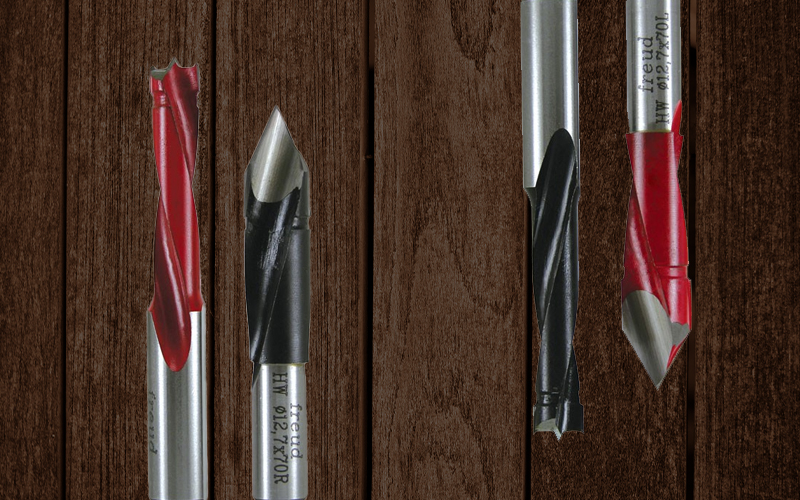You know that feeling when you’re halfway through a cabinet job and your boring bit starts wandering? Or when you’re drilling shelf pin holes in melamine and get that awful chip-out on the exit side? We’ve all been there. The truth is, your 32mm line boring machine is only as good as the bits you put in it.
After watching countless cabinet makers and furniture builders struggle with the wrong tooling, I’ve learned that choosing the right boring bit isn’t just about diameter—it’s about matching the tool to your material, your project, and honestly, your sanity.
The Four Boring Bits Every Shop Needs
Let’s talk about the workhorses of the boring world. These aren’t fancy or complicated, but they’ll handle 90% of what comes through your shop door.
Brad Point Bits: Your Go-To for Clean Holes
If you’re only going to invest in one type of bit, make it brad point bits. That sharp center point doesn’t just look nice—it’s doing real work, keeping your hole exactly where you want it and preventing that heartbreaking chip-out on delicate veneered panels.
I’ve watched cabinet makers transform their work just by switching from regular twist bits to quality brad points. Brands like Amana Tool, Leitz, and Freud know what they’re doing here. The 5mm to 10mm range covers most shelf pin applications, and trust me, your customers will notice the difference in finish quality.
Dowel Drill Bits: When Precision Matters Most
Dowel joinery is an art form, and it demands bits that understand the assignment. These aren’t your standard boring bits—they’re engineered with two or three flutes that create perfectly round holes with smooth walls. Think of them as the tailored suit of the boring bit world.
Guhdo, Famag, and Leuco have built their reputations on bits that drill deeper holes while maintaining that critical roundness. When you’re betting the strength of a joint on the fit between dowel and hole, these bits earn their keep in the 8mm to 12mm range.
Through-Hole Bits: For When You Need a Clean Exit
Here’s where things get interesting. Through-hole bits—sometimes called V-point or split-point bits—solve one of woodworking’s most frustrating problems: blow-out on the exit side. You know what I’m talking about. That ragged, splintered mess that makes your heart sink.
These bits are designed to cut cleanly all the way through, making them perfect for hardware prep and knock-down fittings. Sistemi Klein and Amana Tool have mastered this design, creating bits that maintain their sharpness through heavy production runs.
Combination Bits: The Efficiency Game-Changers
Sometimes the smartest solution is doing two operations in one pass. Counterbore and combination bits let you drill your dowel hole and create your countersink for hardware simultaneously. It’s not just about saving time—though you will—it’s about consistency.
When you’re installing Rafix, Minifix, or Confirmat fittings day after day, these bits from companies like Gannomat, Blum, and Lamello become production heroes. They understand that in a busy shop, every second counts, and every operation is an opportunity for something to go slightly wrong.
Keeping Your Bits Sharp and Your Sanity Intact
Here’s something they don’t teach in woodworking school: bits don’t just get dull, they get clogged. Resin, dust, and debris build up faster than you’d think, especially when you’re working with MDF or melamine. That buildup doesn’t just slow you down—it actively works against you, creating more tear-out and rough finishes.
The solution isn’t complicated, but it requires discipline. Regular cleaning with a specialized bit cleaner or pitch remover dissolves that resin buildup and restores your cutting edges. After cleaning, take a moment to inspect for damage or wear. A worn bit is like a dull knife—dangerous and inefficient.
This isn’t just maintenance theater. Proper care extends bit life, prevents poor cuts, and reduces rework. In a production environment, that translates directly to profit.
The Real Cost of Cheap Tooling
I’ve seen shops try to save money on boring bits, and I understand the impulse. Quality bits require an investment. But here’s what I’ve learned from cabinet makers who’ve made the switch: cheap bits are expensive in ways that don’t show up on the invoice.
Poor-quality bits dull faster, cut rougher, and create more waste. They break at inconvenient times and produce inconsistent results. When you’re trying to build a reputation for quality work, your tooling is either helping or hurting that effort.
Quality bits from established manufacturers aren’t just about bragging rights—they’re about predictable results, extended tool life, and the confidence that comes from knowing your equipment won’t let you down in the middle of a critical job.
Making the Right Choice for Your Shop
The perfect boring bit setup depends on your typical projects and materials. A high-volume cabinet shop running melamine all day has different needs than a custom furniture maker working with exotic hardwoods. A construction company boring holes for hardware installation needs different tooling than a millwork manufacturer creating precision joinery.
But regardless of your specialty, the principle remains the same: match your bits to your materials and projects, invest in quality, and maintain them properly. Your 32mm line boring machine can only deliver precision if you give it the right tools to work with.
The difference between frustrating days filled with tear-out and rework, and smooth production runs with predictable results, often comes down to the bits spinning in your machine. Choose wisely, maintain them well, and your boring operations will become one of your shop’s strengths rather than a source of stress.
When you’re ready to upgrade your tooling or need guidance on the best options for your specific applications, we’re here to help you find the perfect fit for your shop’s needs.


No responses yet